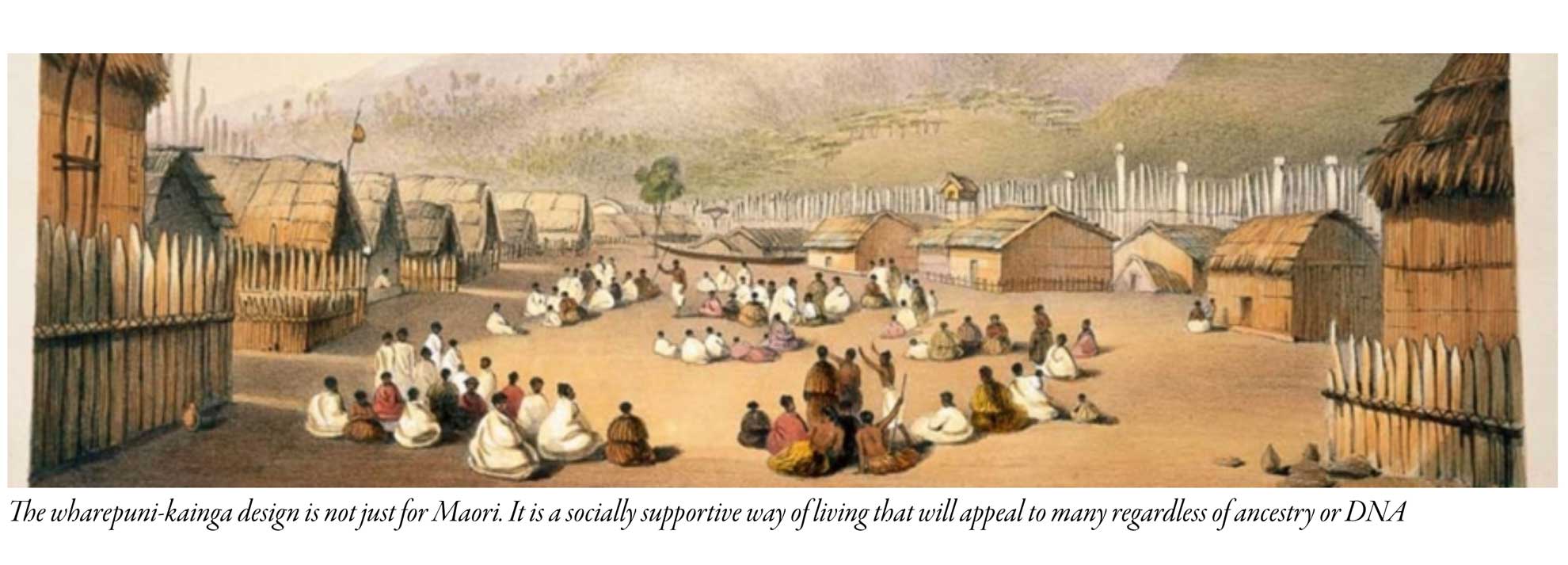Bold Solutions
Learn from those who came before.
Te Kainga o Nga Wharepuni
A development pattern as old as Aotearoa, relevant for today.

Past
Before colonisation, Aotearoa had a development pattern called the Kainga; the Māori village.
Dozens, sometimes hundreds of small family homes called wharepuni would be placed on the kainga, where the small size worked because of three large public spaces, the wharenui (meeting hall), wharekai (dining hall) and whare whaihanga (workshop). The kainga had a different concept of land use.
The wharepuni were not on allotments; the land was not a marketable commodity. They had a right-to-occupy so long as that right was exercised. When the right was extinguished, the land reverted to open space, unaltered.
While the Resource Management Act speaks about enabling people and communities to provide for their social, economic and cultural wellbeing, in practice NZ does not score well. Too many people are lonely, socially isolated, struggling to get by where culture has been replaced by consumerism. It feels normal, but it is not.
The Possible Present
Imagine taking a large piece of land – almost anywhere in New Zealand… over 99% of good land in NZ is rural, we have more unpopulated arable land that almost anywhere else on the planet.
Imagine designating it as whenua, not real estate. Not Māori title, it can remain in fee simple. But the relationship to land is understood in terms of tikanga not tenure. In legal terms, it is a right to occupy – as long as it is needed, the people and community may remain. When that time is passed, it reverts to empty land awaiting its next role to serve the needs of future generations.
Then start thinking about people’s needs and aspirations. Begin by thinking about money. NZ has the highest ratio of house prices to earnings on the planet. That is not a good statistic. Let’s drop the price of a new home to $60,000. No, there is not a zero missing, the comma is in the right place. $60,000 or $250/week is the median price of a mobile home – comparable in size and function to the precolonial wharepuni. At $250 a week, a minimum-wage worker will pay 1/3 of their after tax income; a 1:3 multiple, which is where earnings:house price should be.
Next let’s talk about social connection. Facebook is no substitute for face-to-face connection. People are social animals, not loners… [editing in process]
THE IMMEDIATE FUTURE
Land is staked out marking where wharepuni will sit. Stake where the three removable marquees will stand. Stake out the carpark. Mark lines on the ground showing where the trencher will bury water & wastewater pipes and electrical conduit. Note: No survey, no subdivision, only stakes and lines.
The wharepuni are mobile homes, manufactured in factories, towed to site, installed in a matter of hours, and most importantly are removable 15-years later in a matter of hours leaving only bare topsoil.
The carpark is set near the road, no cars within the living area. A permeable fabric is placed on top of the topsoil and a layer of crushed rock is laid on top. This forms a temporary carpark that can be removed. Similarly, paverstones are laid on the ground to form footpaths for walking, cycling and hand trolleys from car to home.
A trencher buries the pipes and conduits to each standpipe where the mobile home is parked. This is a permanent change to the land, but a positive one. In 15 years when the land reverts to high-production market farming (typically growing 4kg of food per m² in contrast to the 80 grams of milk solids per m² that NZ’s dairy industry yields), when the mobile homes are removed, the topsoil has built in irrigation pipes as well as power sources for robotic farming which is expected to displace heavy tractors and farm implements.
The wharenui marquee, with benches and tables is used for childcare and upon occasion for gatherings
The wharekai has a BBQ and picnic tables. It is used for social dining. In large kainga it may have a food kiosk
The whare whaihanga is what makes the kainga economically sustainable. Instead of everyone driving away to work somewhere else, or relying on the benefit, people are able to make and sell things. With the very low cost of living that is inherent in kainga living, this gives economic independence as well as meaning.